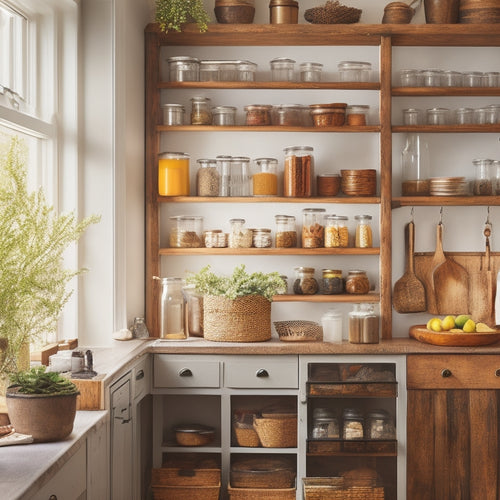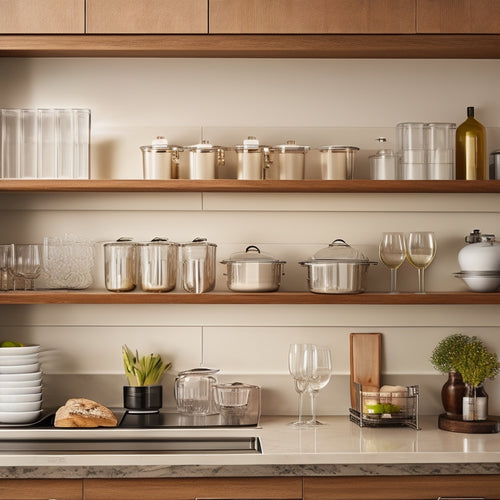
Revamp Kitchen Storage: Master the Toe-Kick Drawer
Share
To revamp kitchen storage, master the art of toe-kick drawers, where thoughtful design and precision construction can reveal hidden potential. Optimize the often-underutilized toe-kick space by determining the ideal size and placement for seamless integration. A well-designed drawer should prioritize organization, visibility, and accessibility, incorporating dividers, inserts, or trays for tailored storage solutions. With durable materials, precise cuts, and meticulous attention to detail, create a functional and aesthetically pleasing drawer that elevates kitchen workflow and style. As you perfect the art of toe-kick drawers, discover how the nuances of design and construction come together to transform your kitchen.
Key Takeaways
• Determine ideal toe-kick size and placement to maximize space and functionality for efficient drawer installation.
• Design the perfect drawer with consideration for size, placement, and functionality to prioritize organization and accessibility.
• Construct a strong and dependable drawer box using high-quality plywood and precise measurements for a seamless fit.
• Assemble the final product with attention to detail, ensuring accurate alignment of drawer rails and tailored customization.
• Experiment with unique drawer measurements and installation methods to elevate kitchen functionality and workflow.
Toe-Kick Size and Placement
When designing the toe-kick area, determining the ideal size and placement of the toe-kick itself is crucial, as it sets the stage for the subsequent installation of toe-kick drawers.
To maximize space, consider skipping the front portion of the toe kick for drawer inclusion.
For IKEA cabinets, rip 26s down to 4.5' tall to ensure a finished countertop height of 36' off the floor.
This thoughtful approach enables efficient toe kick drawer functionality, allowing you to make the most of this often-underutilized space.
Designing the Perfect Drawer
With precision and attention to detail, designing the perfect toe-kick drawer requires careful consideration of its size, placement, and functionality to maximize the potential of this often-overlooked kitchen storage space. A well-designed drawer should prioritize organization, making sure that contents are easily accessible and visible.
Consider incorporating dividers, inserts, or trays to create a bespoke storage system tailored to your needs. When selecting drawer materials, opt for durable, easy-to-clean options such as solid wood, MDF, or high-quality laminate. Guarantee the drawer's interior is thoughtfully designed to accommodate your kitchen essentials, from utensils to cookware.
Building the Drawer Box
To guarantee a strong and dependable toe-kick drawer, begin by constructing the drawer box using a simple yet efficient design. Opt for a plywood box that will provide the necessary strength and durability.
For drawer construction, material selection is essential. Choose a high-quality plywood that can support the weight of the contents.
Consider the aesthetic options for the drawer handle, such as a sleek metal or a decorative wood design, to complement your kitchen's style.
Ensure accurate measurements and precise cuts to secure a seamless fit. Use pocket screws and wood glue to reinforce the joints, and avoid gluing the drawer bottoms or door panels for flexibility.
With a solid drawer box in place, you'll be well on your way to creating a functional and stylish toe-kick drawer.
Assembling the Final Product
Accuracy assembly is crucial in bringing the toe-kick drawer to life, as it requires meticulous attention to detail to guarantee a seamless fusion of form and function.
As you assemble the final product, make sure precise alignment of the drawer rails, using a combination square and wood spacers to maintain uniform height. This attention to detail will elevate the drawer's functionality and aesthetics, allowing for smooth operation and efficient storage.
Consider tailoring the drawer's customization to your specific needs, incorporating clever organization solutions to maximize its potential.
Share Your Thoughts
In the realm of kitchen storage solutions, the modest toe-kick drawer has emerged as a stylish and sophisticated game-changer, prompting the question: what inspired your own toe-kick drawer creation, and how has it transformed your culinary space?
As you ponder on your toe-kick drawer journey, consider sharing your experiences, tips, and challenges. Perhaps you experimented with unique drawer measurements or installation methods, or chose a specific material for its durability.
What design elements did you prioritize for a seamless integration with your kitchen aesthetic?
How did you secure a smooth installation process, and what tools proved essential?
What benefits have you noticed in your kitchen's functionality and workflow since incorporating the toe-kick drawer?
Frequently Asked Questions
Can I Use MDF Instead of Plywood for the Drawer Box?
When considering material options for the drawer box, MDF can be a viable alternative to plywood, but design considerations must prioritize moisture resistance and durability, as MDF may be more prone to water damage and sagging.
How Do I Handle Uneven Floor Surfaces for Toe-Kick Installation?
'When installing toe-kick drawers on uneven floors, think of a ship sailing rough seas - floor leveling is essential. Guarantee a stable base with precise measurements, and customize trim to conceal any gaps, resulting in a seamless installation that's both functional and visually appealing.'
Are Soft-Close Drawer Slides Necessary for Toe-Kick Drawers?
While soft-close drawer slides are not necessary for toe-kick drawers, they enhance drawer organization and cabinet customization by providing a seamless, quiet closing experience, ensuring best drawer functionality and a refined installation finish.
Can I Add Electrical Outlets or USB Ports Inside the Toe-Kick Drawer?
"Imagine a clutter-free kitchen where devices charge discreetly within a toe-kick drawer. Yes, you can add outlets or USB ports, but prioritize cable management and space optimization while addressing safety concerns and a meticulous installation process."
What Is the Recommended Weight Capacity for a Toe-Kick Drawer?
When designing a toe-kick drawer, consider a weight capacity of 50-75 pounds, depending on materials and installation. Choose durable toe kick materials, such as 3/4' plywood, and a sturdy drawer design with reinforced joints for best load-bearing capacity.
Related Posts
-

Revolving Cabinet Organizer Lazy Susan
A revolving cabinet organizer like a Lazy Susan is a transformative solution for your kitchen. It maximizes space and...
-

Creative Organization Ideas for Tight Kitchen Spaces
To create an organized kitchen in tight spaces, think upwards. Install shelves that reach the ceiling and use wall-mo...
-

Pull-Out Cabinet Shelves for Dish Drainer Storage
Pull-out cabinet shelves are a revolutionary innovation for your dish drainer storage. They maximize vertical space a...


